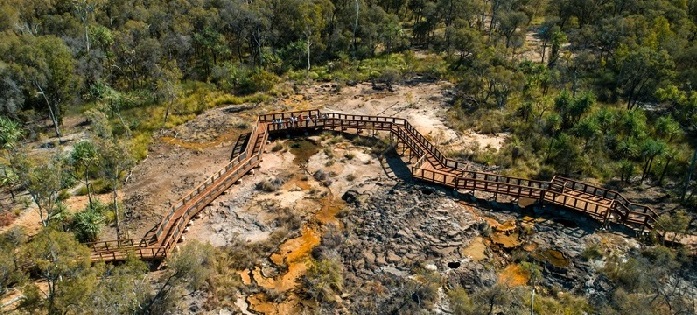The challenge
Building on Indigenous capability
Indigenous Australians now have recognition as owners, custodians, caretakers and native title rights holders of over 40 per cent of the Australian landscape and their holdings continue to grow.
This rapid change to the landscape requires new approaches to social, cultural, and economic development, and new forms of environmental management.
Indigenous people need accurate information about their country and how it can be used and managed sustainably to create benefits for their communities. They also need improved capability to attract investment in the on-country Indigenous corporations and enterprises they wish to create. In turn, wider society needs greater understanding of the opportunity provided by Indigenous ownership of country, and the contribution this can make to the future sustainability and prosperity of the nation.
Our response
Working together on developing Indigenous land and water enterprises
Supported by the National Indigenous Australians Agency of the Commonwealth Government, CSIRO collaborated with the National Native Title Council (NNTC) to identify and partner with local Indigenous landowners seeking to understand their country better and create economic opportunities from that country. This joint project tested pathways for co-developing the scientific, Indigenous knowledge, and business opportunity information needed to attract investment. Grounded in local collaborations, it also provided case studies, examples, and a how to guide to support Indigenous on-country development elsewhere.
The three on-country locations and local collaborators were:
- Talaroo Nature Refuge and Indigenous Protected Area in North Queensland, owned by the Ewamian people
- Peedamulla Station in Western Australia, leased by Jundaru Aboriginal Corporation and co-managed with Ashburton Aboriginal Corporation
- The traditional lands of the Western Yalanji people of North Queensland who are represented by the Western Yalanji Aboriginal Corporation.
The North Queensland Land Council was a key regional collaborator, and CSIRO provided additional support to the project through the provision of postdoctoral fellow Taryn Kong. A further collaboration with Griffith University enabled film outputs from the Ewamian case as part of the project.
The results
Strong collaborations for the future
The project ran from 2017 to 2022, achieving key milestones, taking advantage of new opportunities, and adapting to rapidly changing circumstances. These changes included local developments amongst the partners as well as the COVID-19 pandemic. Strong collaborations sustained the team through this extended project journey and in turn provided important lessons for successful co-development with Indigenous corporations and enterprises.
A crucial focus for the project was to create readable, accessible, and visually appealing publications that would suit local Indigenous partner needs as well as communicate important information to wider audiences. These audiences include other Indigenous corporations and communities looking to develop their potential investors, supporters and stakeholders, and the wider nation. The publications include prospectuses about each of the three local partner locations. It also includes a ‘how to guide’ based on our combined experience and providing key lessons for those Indigenous corporations wanting to follow a similar path of understanding sustainable economic opportunities and attracting investment.
More information about the project partners and outcomes can be found below. Further detail is also available in the project final report.

The case studies
Ewamian Limited, formerly Ewamian Aboriginal Corporation, holds native title over 2.9 million hectares in the upper Gilbert and Einasleigh River Catchments in North West Queensland. Ewamian Limited owns Talaroo Station, a 31,000 hectare pastoral property and Nature Refuge featuring hot springs. The property has high cultural, environmental, and potential economic value. With the support of CSIRO and many other stakeholders, Ewamian Limited successfully launched a tourism development in 2021. More information about this project can be found in the prospectus on the Investment Partnerships with Ewamian People PDF (8 MB).
In Western Australia’s Pilbara region, Ashburton Aboriginal Corporation operate the 225,000 hectare Peedamulla Station on behalf of the long term custodians of the area, Jundaru Aboriginal Corporation (JAC). Fed by the Cane River, the station supports a significant cattle business. The project team collaborated to produce a joint AAC/JAC prospectus that highlighted sustainable pastoral development opportunities and complementary opportunities in environmental mitigation and management. Further information about our Peedamulla collaboration is available in the Prospectus for Partnership with Jundaru and Ashburton Aboriginal Corporations PDF (4 MB).
In North Queensland, the Western Yalanji Aboriginal Corporation (WYAC) represents the traditional owners of the customary estate from the headwaters of the Palmer and Mitchell Rivers to lands surrounding the township of Laura. This includes a combination of exclusive and non-exclusive native title and freehold land. The project collaboration with WYAC assessed tourism opportunities suitable for the corporation and the people it represents, creating a shortlist of opportunities presented in the WYAC prospectus. You can find more information about the WYAC case study in A Prospectus for Partnering with Western Yalanji Aboriginal Corporation PDF (5 MB).
Corporate capability
This project was crucial in growing the capability of all the partners to participate in future development opportunities. It provided an example of successful partnerships across Indigenous corporations, research, and government. It further established CSIRO’s role as an integration science expert and trusted advisor in sustainable on-country Indigenous development. It has led directly to further CSIRO project collaborations with the National Indigenous Australians Agency and other federal departments. The project enabled the National Native Title Corporation to significantly enhance its membership, staffing, and profile amongst native title holders. Our team’s local partners all created new opportunities and positioned themselves for the next chapter of their development.
Documents included on this page may not be accessible to assistive technologies. If necessary, please contact us to request further accessibility assistance.
Media liaison
